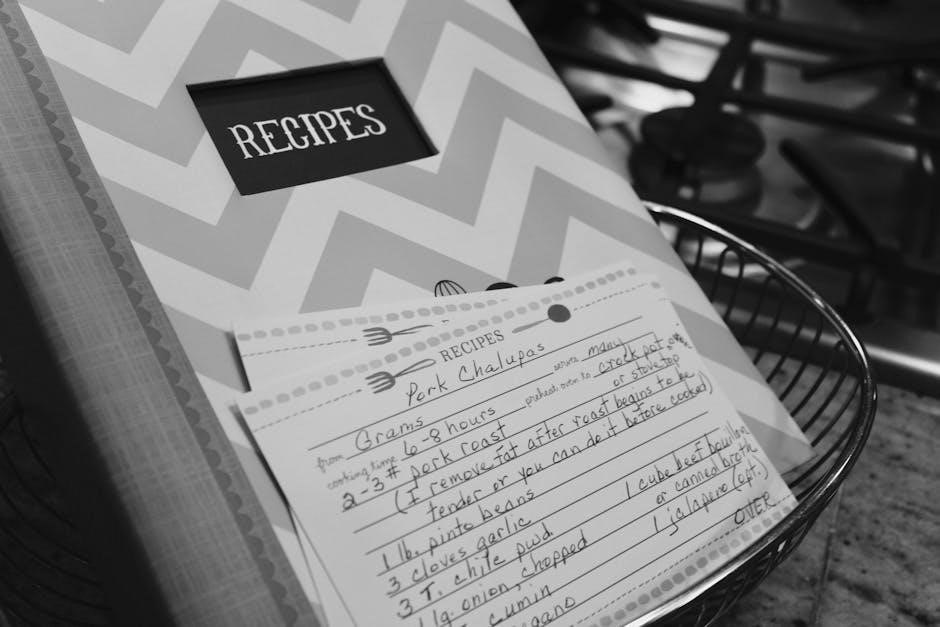Identify and resolve common gas stove issues with this comprehensive guide․ Address problems like ignition failure, uneven flames, and burner malfunctions․ Regular maintenance and proper cleaning can prevent major repairs․ Stay safe and ensure optimal performance with expert tips․
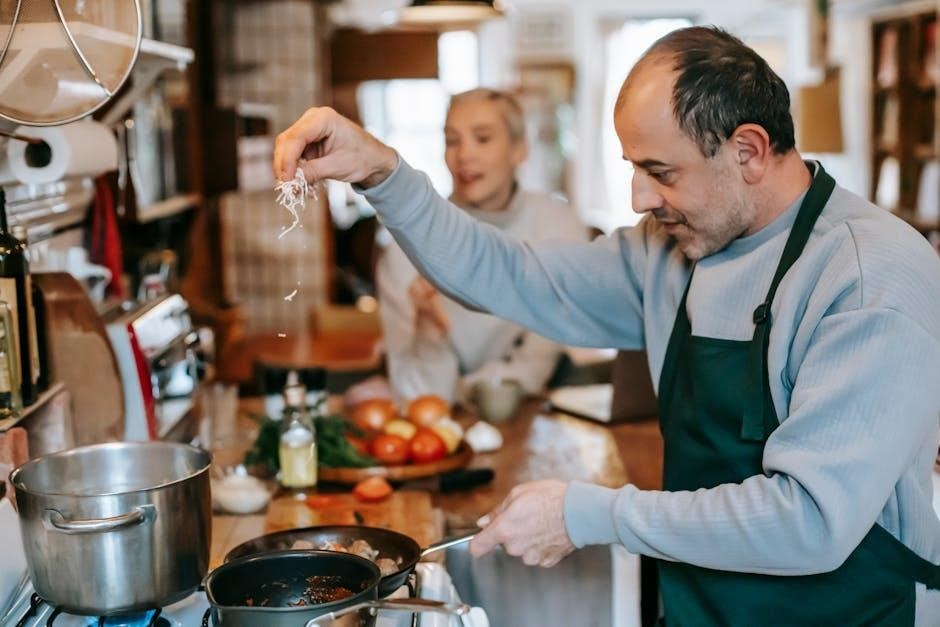
Common Gas Supply Issues
Gas supply problems are among the most frequent issues with gas stoves․ If your stove isn’t functioning, it could be due to a disruption in the gas flow; Common causes include blockages in the gas line, faulty shut-off valves, or issues with the gas regulator․ Debris, grease, or rust can clog the gas passages, preventing the fuel from reaching the burners․ Additionally, improper installation or recent repairs might disrupt the gas connection․ To diagnose, ensure the shut-off valve is fully open and check for visible damage or kinks in the gas line․ If the problem persists, inspect the burner ports for blockages, as food particles or spills can obstruct the gas flow․ Cleaning the ports with a needle or small brush may resolve the issue․ Always ensure proper ventilation and verify that the gas supply is active before attempting repairs․ Addressing these issues promptly can restore your stove’s functionality and safety․
Igniter Problems
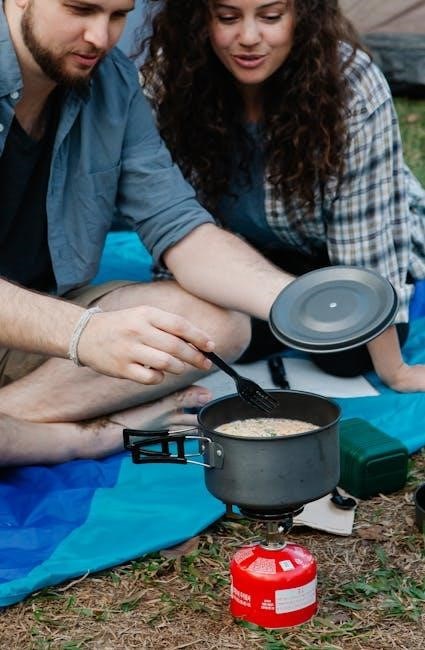
Igniter issues are a common concern in gas stoves, often manifesting as a failure to light the burner or inconsistent sparking․ The igniter, responsible for producing the spark that ignites the gas, can malfunction due to wear and tear or dirt accumulation․ Over time, the igniter tip may become clogged with food debris or grease, preventing the spark from reaching the gas․ Additionally, moisture or humidity can interfere with the igniter’s functionality, causing intermittent sparking or complete failure․
To address igniter problems, ensure the area around the igniter is clean and dry․ Use a soft brush or toothbrush to gently remove any residue․ If the igniter is damaged or corroded, it may need replacement․ Always check the spark gap alignment, as misalignment can prevent proper ignition․ If the igniter continues to malfunction despite these efforts, consult a professional for further diagnosis or replacement․ Regular maintenance can help prevent igniter issues and ensure reliable stove performance․
Burners Not Igniting
If your gas stove burners are not igniting, it could be due to several issues․ First, check if the burner cap is properly aligned and seated, as misalignment can disrupt the flame․ Ensure the burner ports are clear of debris, as clogged ports can prevent gas from flowing properly․ Use a toothbrush or small pin to clean out any blockages․ Additionally, verify that the gas supply valve is fully open and that the stove is receiving gas․
Another common cause is a faulty igniter electrode or spark module․ If the igniter is not sparking, the burner won’t ignite․ Test the spark by turning the knob and observing if sparks are present․ If no spark occurs, the issue may lie with the ignition system or electrical connections․ Check for loose wires or corrosion in the spark module and clean or replace them as needed․ If the problem persists, it may be related to the gas regulator or burner orifice, which could require professional adjustment or replacement․ Always ensure the stove is cool before attempting any repairs to avoid injury․
Uneven or Yellow Flames
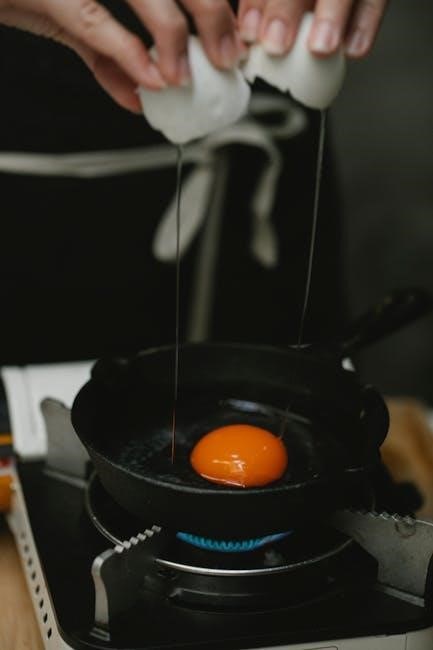
Uneven or yellow flames on your gas stove can indicate improper combustion or issues with the burner components․ One common cause is a clogged or dirty burner port, which disrupts the flow of gas and air․ Clean the burner ports regularly using a toothbrush or small pin to remove food debris or residue․ Additionally, check the burner cap for proper alignment, as a misaligned cap can cause uneven flames․ If the flames appear yellow, it may suggest incomplete combustion due to insufficient oxygen supply․ This could be due to a blocked air shutter or improper adjustment of the burner’s air-to-gas mixture․ Adjust the air shutter to ensure adequate airflow, but avoid over-adjusting, as this can lead to other issues․ If the problem persists, inspect the burner head or base for damage or wear, as this can disrupt the flame pattern․ Always ensure the stove is cool before cleaning or adjusting parts․ Yellow flames can also indicate carbon monoxide production, so address this issue promptly to maintain safety․ Regular maintenance and proper cleaning can help restore even, blue flames and ensure efficient combustion․ If the issue recurs despite cleaning, consult a professional for further diagnosis․
Oven Not Heating
If your gas stove’s oven is not heating, there are several potential causes to investigate․ First, ensure that the oven is properly preheated and that the temperature dial is set correctly․ Check if the oven igniter is functioning; if it’s faulty, the oven may not light at all․ Verify that the gas supply line is open and that there are no leaks or blockages; If the oven has an electronic ignition system, ensure it’s receiving power․ A blown fuse or tripped circuit breaker could also prevent the oven from heating․ Inspect the burner orifice for obstructions, as food debris or dirt can block the gas flow․ Additionally, check the oven’s thermostat or temperature sensor for accuracy, as a malfunction here can prevent proper heating․ If the issue persists, it may be related to the oven’s safety valve or ignition module․ Always turn off the gas supply before attempting repairs and ensure proper ventilation to avoid gas buildup․ If you’re unsure about the cause, it’s best to call a professional for assistance․ Regular maintenance and inspections can help prevent such issues․
Gas Burner Clicking but Not Lighting
If your gas burner is clicking but not lighting, it could indicate an issue with the ignition system․ The clicking sound typically comes from the igniter trying to spark the burner․ First, check if the burner cap is properly aligned, as a misaligned cap can prevent the flame from igniting․ Ensure the burner and surrounding area are clean, as food debris or spills can interfere with the igniter’s function․ Moisture in the burner or igniter can also cause this issue, so allow it to dry completely before retrying․ If the problem persists, inspect the igniter for wear or damage; a faulty igniter may need replacement․ Additionally, check for blockages in the burner ports, as clogged ports can prevent gas from flowing properly․ If the burner still doesn’t light, there might be an issue with the gas supply or the ignition module․ Always ensure the gas supply is turned on and verify that there are no leaks or obstructions in the gas line․ For persistent problems, it may be necessary to consult a professional to diagnose and repair the issue safely․ Regular maintenance, such as cleaning the burner and igniter, can help prevent this problem from occurring․ By addressing these potential causes, you can restore proper functionality to your gas burner․ Remember to prioritize safety when working with gas appliances and seek expert help if unsure․
Misaligned Burner Caps
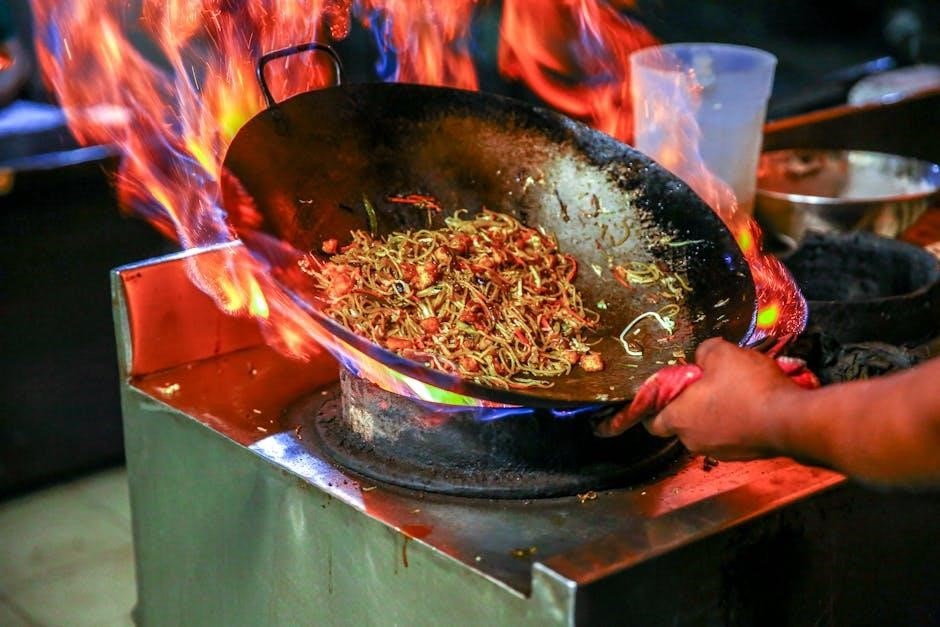
Misaligned burner caps are a common issue that can disrupt the proper functioning of your gas stove․ If the burner caps are not properly seated or are tilted, they may cause uneven flames or prevent the burner from igniting altogether․ To check for misalignment, remove the burner cap and inspect its position․ Ensure it is centered and fits snugly over the burner base․ If the cap is crooked or loose, align it correctly and test the burner again․ Misaligned caps can also lead to gas escaping unevenly, resulting in inconsistent cooking performance․ Regular cleaning of the burner caps is essential, as food residue and debris can affect their alignment․ If the issue persists after realignment, it may be necessary to replace the burner cap․ Properly aligned caps ensure optimal flame distribution and safety․ Always refer to your stove’s manual for specific guidance on burner cap adjustment and maintenance․ Addressing this issue promptly can prevent further complications and maintain your stove’s efficiency․
Clogged Burner Ports
Clogged burner ports are a frequent issue in gas stoves, often caused by food debris, spills, or dirt accumulation․ When the small holes in the burner ports become blocked, the gas flow is restricted, leading to weak or uneven flames, or even preventing the burner from lighting altogether․ To address this, turn off the stove and allow it to cool completely․ Use a toothbrush or small nylon brush to gently sweep away loose debris from the ports․ For tougher clogs, mix baking soda and water to form a paste, apply it to the affected area, and let it sit for 15–20 minutes before scrubbing․ Avoid using harsh chemicals or abrasive materials, as they may damage the burner․ After cleaning, rinse with warm water and dry thoroughly before reigniting the burner․ Regular maintenance can help prevent clogs and ensure consistent performance․ If the problem persists, it may indicate a deeper issue requiring professional attention․ Always prioritize safety when working with gas appliances․
Low Flame on Gas Stove Burner
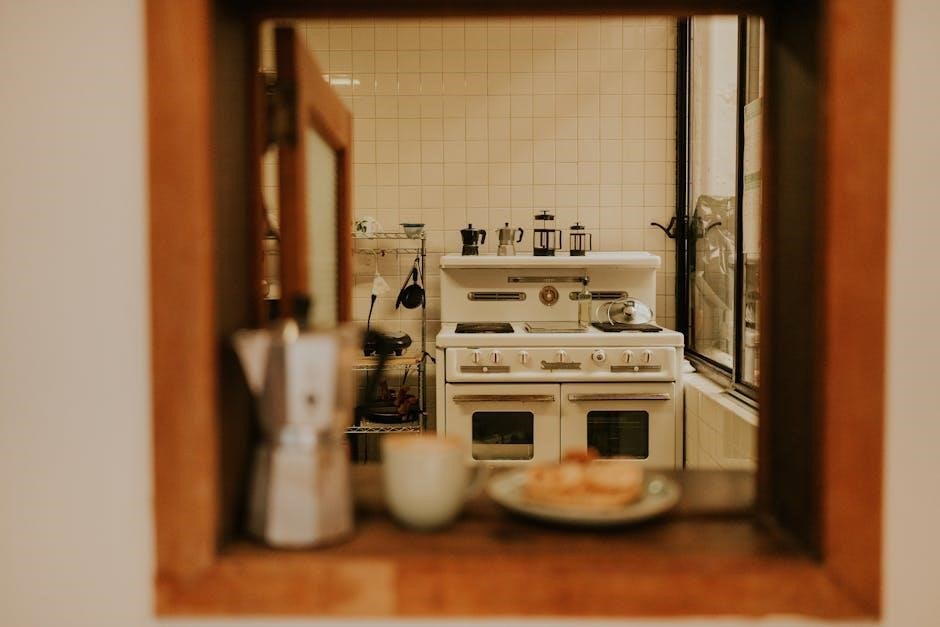
A low flame on a gas stove burner can be caused by several factors, including improper gas pressure settings, a malfunctioning regulator, or clogged burner ports․ First, check the gas supply line to ensure it is fully open․ If the issue persists, inspect the burner ports for blockages, as debris or food residue can restrict gas flow․ Clean the ports using a small brush or toothbrush to remove any obstructions․ Additionally, ensure the air shutter (if your stove has one) is properly adjusted, as a closed shutter can reduce airflow and result in a low flame․ If the flame remains weak, it may indicate a problem with the gas regulator or a faulty burner cap․ Avoid using the stove until the issue is resolved, as a low flame can lead to incomplete combustion and potential safety hazards․ If troubleshooting steps do not resolve the problem, it may be necessary to replace the burner or consult a professional for further assistance․ Always prioritize safety when working with gas appliances․ Regular maintenance can help prevent such issues from arising․
Safety Concerns and Precautions
When troubleshooting or using a gas stove, safety should always be the top priority․ Gas stoves involve open flames and pressurized fuel, which can pose significant risks if not handled properly․ Always ensure the kitchen is well-ventilated to prevent the buildup of harmful gases like carbon monoxide․ Never leave a burning stove unattended, as this can lead to accidental fires or burns․ Keep flammable materials, such as curtains, towels, or loose clothing, away from the stove․ If you suspect a gas leak, immediately turn off the supply, open windows for ventilation, and avoid using any electrical switches or appliances until the issue is resolved․ Never attempt to repair a gas stove yourself unless you are fully confident in your abilities, as improper repairs can lead to dangerous situations․ Additionally, never allow children to play near the stove or attempt to operate it․ If you feel uncertain or uncomfortable addressing a problem, it is always best to contact a qualified professional․ Safety precautions should never be overlooked to prevent accidents and ensure safe operation․ Regular inspections and maintenance can also help identify potential risks early․ Always follow the manufacturer’s guidelines for safe usage․
Troubleshooting Ignition Failure
Ignition failure on a gas stove can be frustrating, but it’s often caused by specific issues that can be identified and resolved․ Start by checking the circuit breaker or fuse box to ensure the stove’s power supply is intact․ If the ignition system relies on electricity, a tripped breaker or blown fuse could be the culprit․ Next, inspect the spark or click mechanism․ If you hear no spark or click when attempting to light a burner, the igniter module or wiring may be faulty․ Use a multimeter to test for continuity in the ignition circuit to identify any breaks or short circuits․ Additionally, ensure the burner cap is properly aligned, as a misaligned cap can disrupt the spark’s path to the burner․ Clean the burner and surrounding area to remove any debris that might block the ignition․ If the issue persists, it may be necessary to replace the igniter or spark electrode․ Always ensure the stove is cool before attempting repairs, and consider consulting a professional if the problem is not resolved․
Gas Leaks and Detection
Gas leaks are a critical safety concern that require immediate attention․ To detect a gas leak, look for signs such as a strong sulfur or gas odor, hissing sounds near the stove, or bubbles forming when soapy water is applied to connections․ If a leak is suspected, turn off the gas supply at the shut-off valve, open windows for ventilation, and avoid using any electrical appliances or open flames․ Never attempt to repair a gas leak yourself; instead, contact a licensed technician or your gas provider․ Regularly inspect hoses, connections, and gaskets for signs of wear or damage․ Replace any corroded or loose parts to prevent leaks․ If your stove is equipped with a gas leak detector, ensure it is functioning properly․ Always follow the manufacturer’s guidelines for maintenance and safety․ Addressing gas leaks promptly is essential to prevent accidents and ensure safe operation of your gas stove․
Cleaning and Maintenance Tips
Regular cleaning and maintenance are essential to ensure the optimal performance and safety of your gas stove․ Start by wiping down the stove surface after each use with a damp cloth to remove food residue and spills․ For tougher stains, mix baking soda and water to create a paste, apply it to the affected areas, and let it sit before scrubbing․ Remove and clean burner grates and caps periodically, soaking them in warm soapy water to loosen grease․ Use a soft brush to clean burner ports and ensure they are free from debris․ Avoid using abrasive cleaners or scourers, as they can damage the finish or harm the igniter․ Check and clean the drip pans regularly to prevent grease buildup․ Inspect hoses and connections for signs of wear and tighten any loose fittings․ Always unplug the stove before deep cleaning and avoid getting electrical components wet․ By maintaining a clean and well-maintained stove, you can enhance efficiency, prevent issues, and extend its lifespan․
Ventilation Issues
Proper ventilation is crucial for safe and efficient gas stove operation․ Inadequate ventilation can lead to a buildup of heat, moisture, and combustion byproducts, creating an unsafe kitchen environment․ Common signs of ventilation issues include excessive condensation on windows, lingering cooking odors, or a stuffy atmosphere․ To address this, ensure your kitchen is well-ventilated by installing or using an exhaust fan that vents outside․ Clean or replace filters regularly to maintain airflow efficiency․ If ventilation remains poor, consider upgrading to a more powerful range hood or ensuring ducts are clear of blockages․ Additionally, check for gaps or leaks in ductwork that might reduce ventilation effectiveness․ Proper airflow not only enhances cooking comfort but also helps prevent potential safety hazards like carbon monoxide accumulation․ Regularly inspect and maintain your ventilation system to ensure optimal performance and a safe cooking environment․
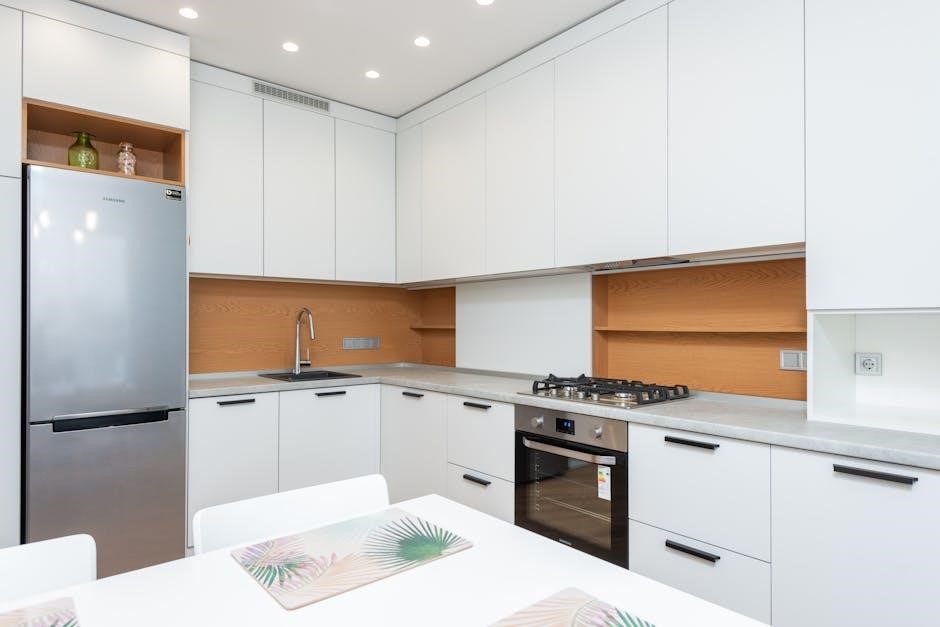
Pilot Light Problems
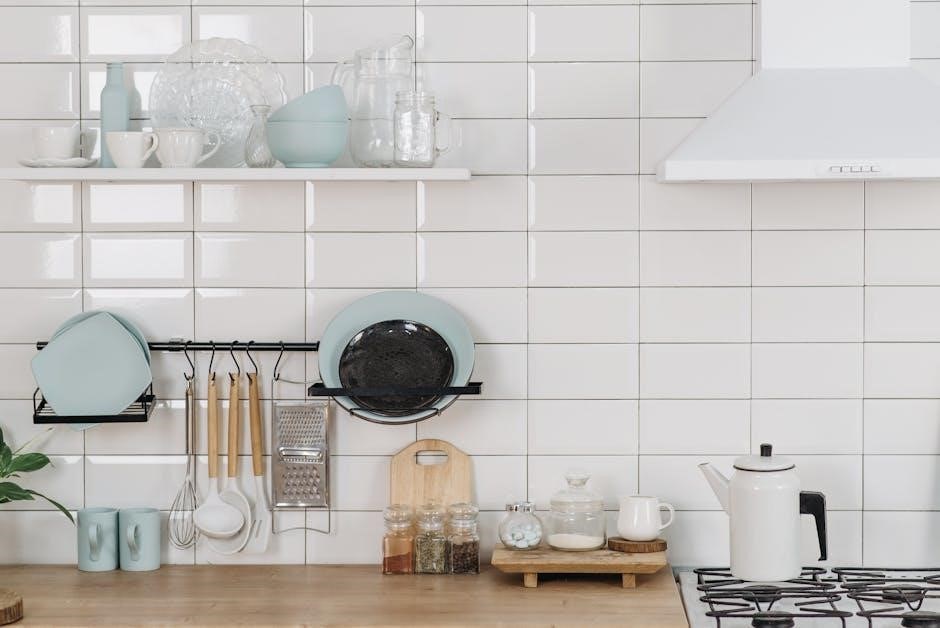
Pilot light issues are common in gas stoves and can disrupt cooking operations․ The pilot light is responsible for igniting the burners when the stove is turned on․ If the pilot light goes out frequently, it could indicate a problem with the thermocouple or gas supply․ A faulty thermocouple may fail to detect the pilot flame, causing the gas valve to shut off․ Additionally, drafts, dirt, or moisture in the pilot tube can extinguish the flame․ To address this, ensure the area around the pilot light is clean and free from obstructions․ If the pilot light refuses to stay lit, try relighting it according to the manufacturer’s instructions․ If the issue persists, it may be necessary to replace the thermocouple or check for gas pressure problems․ Always ensure the burner cap is properly aligned, as a misaligned cap can cause uneven flames or extinguish the pilot light․ If you’re unsure about the cause, it’s best to consult a professional to avoid safety risks․
Flame Going Out Unexpectedly
A flame that goes out unexpectedly on a gas stove can be frustrating and potentially dangerous․ This issue often occurs due to drafts in the kitchen, which can extinguish the flame․ Another common cause is a misaligned or dirty burner cap, which can disrupt airflow and cause the flame to die․ Additionally, low gas pressure or a faulty gas regulator can lead to an unstable flame that flickers or goes out․ To resolve this, ensure the burner cap is clean and properly aligned․ If drafts are the issue, consider using a windshield or moving the stove away from direct airflow․ If the problem persists, check the gas line for leaks or kinks and ensure the gas pressure is set correctly․ In some cases, the issue may stem from a faulty ignition system or a clogged burner port, which requires professional attention․ Always turn off the burner and wait a few minutes before relighting if the flame goes out unexpectedly․ Regular maintenance and inspections can help prevent this issue․
17․Spark Ignition System Malfunction
Spark Ignition System Malfunction
A malfunctioning spark ignition system can prevent your gas stove from lighting properly․ This system generates sparks to ignite the gas when you turn the knob․ Common issues include the spark not appearing, a weak spark, or the spark not reaching the gas․ Moisture, food debris, or dirt on the igniter electrodes can disrupt the spark․ Additionally, wear and tear on the electrodes or a faulty spark module can cause the system to fail․ To troubleshoot, ensure the burner and igniter are dry, as moisture can prevent sparking․ Clean the electrodes gently with a toothbrush to remove any debris․ If the spark is weak, check for proper alignment of the burner cap, as misalignment can disrupt the ignition process․ If the issue persists, inspect the spark wire for damage or looseness and ensure it is securely connected․ In some cases, the spark module may need replacement․ Always turn off the stove and allow it to cool before attempting repairs․ If the problem is unresolved, consult a professional to avoid safety risks․ Regular cleaning and inspections can help maintain the spark ignition system’s efficiency․
Gas Stove Safety Features
Modern gas stoves are equipped with various safety features designed to prevent accidents and ensure safe operation․ One of the most critical features is the flame failure device, which automatically shuts off the gas supply if the flame is extinguished, preventing gas buildup․ Many stoves also include automatic shut-off valves that stop gas flow when the stove is not in use or if an abnormal situation is detected․ Heat-resistant glass on cooktops protects users from burns, while child safety locks prevent accidental ignition by children․ Some models feature pressure regulators to maintain consistent gas pressure, reducing the risk of overpressure․ Additionally, cool-touch panels and thermal protection devices help prevent overheating․ Many stoves also come with gas leak detection systems or sensors that alert users to potential leaks․ Regularly inspecting these features and ensuring they function correctly is essential for maintaining safety․ Always follow the manufacturer’s guidelines to ensure all safety mechanisms are operational․ These features collectively enhance the safety and reliability of gas stoves for everyday use․
Troubleshooting Gas Oven Issues
Gas ovens can sometimes malfunction, leaving you struggling to cook evenly or heat properly․ One common issue is the oven not reaching the set temperature, which could be due to a faulty thermostat or a malfunctioning oven sensor․ If the oven won’t heat at all, check if the pilot light is lit (for older models) or if the ignition system is functioning correctly․ Modern ovens with electronic controls may display error codes, which can help identify the problem․ Issues like uneven heating could stem from a faulty heating element or poor air circulation․ Gas ovens may also experience problems with the gas valve or burner igniter․ Always ensure the oven is preheated properly and that racks are positioned correctly․ If you notice unusual noises or smells, such as gas odors, turn off the oven and investigate immediately․ For persistent issues, consult the user manual or contact a professional to avoid safety risks․ Regular maintenance, such as cleaning vents and checking connections, can prevent many of these problems․
When to Call a Professional
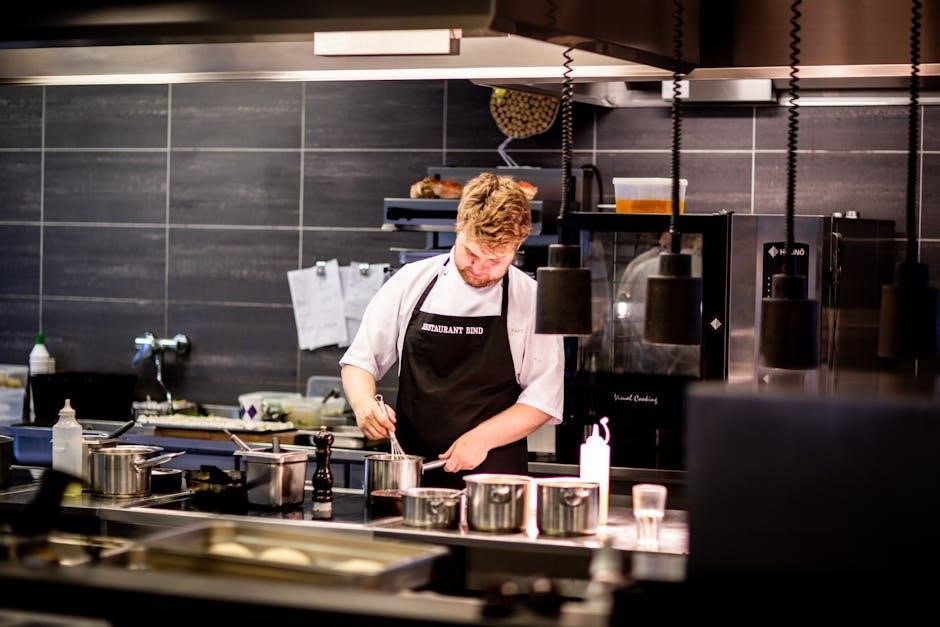
While many gas stove issues can be resolved through DIY troubleshooting, there are situations where it’s best to call a professional․ If you suspect a gas leak, immediately turn off the supply and contact a licensed technician, as leaks pose serious safety risks․ Additionally, if your oven isn’t heating properly despite checking the thermostat and pilot light, professional assistance may be needed to inspect the heating element or gas supply․ Ignition problems, such as persistent clicking or failure to light, often require expert diagnosis to address issues with the igniter or gas flow․ Uneven or yellow flames that don’t improve after cleaning burner caps could indicate deeper problems with burner ports or gas lines, necessitating professional intervention․ Safety concerns, like potential gas explosions or fire hazards, should always be handled by a pro․ Persistent issues that recur after basic troubleshooting also warrant professional attention to prevent further complications․ If you’re unsure about safely performing repairs or encounter complex electrical problems, especially in modern stoves with advanced controls, it’s wise to seek expert help․ Professionals have the tools and expertise to resolve these issues safely and effectively, ensuring your stove operates reliably and securely․
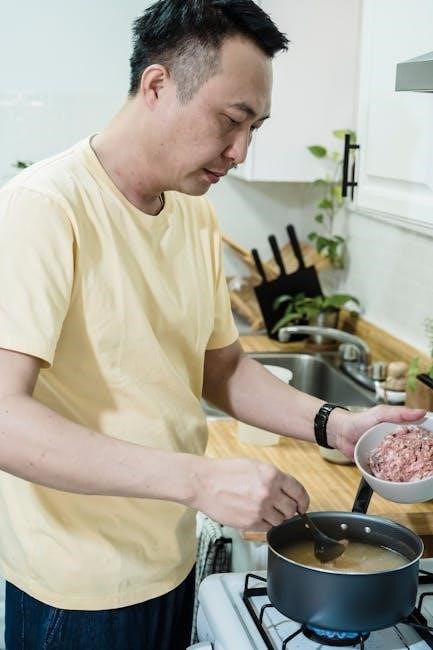
Preventative Measures
Regular maintenance is key to preventing gas stove issues and ensuring optimal performance․ Start by inspecting burner ports and caps for blockages, cleaning them with a small brush or toothpick to maintain proper gas flow․ Check the igniter electrodes for food residue and clean them gently with a soft cloth to ensure reliable ignition․ Avoid using abrasive cleaners or harsh chemicals, as they can damage the stove’s finish or harm the burners․ Always ensure the burner caps are properly aligned and secure after cleaning to prevent misalignment issues․ Regularly inspect the gas hoses and connections for signs of wear or leaks, tightening any loose fittings and replacing worn-out seals․ Keep the stove area clear of flammable materials and ensure proper ventilation to avoid carbon monoxide buildup․ Avoid placing heavy objects on the stove or using high heat for extended periods, as this can strain the burners․ By adopting these preventative measures, you can extend the lifespan of your gas stove, improve safety, and reduce the need for frequent repairs․ Consistent upkeep also enhances efficiency and ensures a safer cooking environment․
